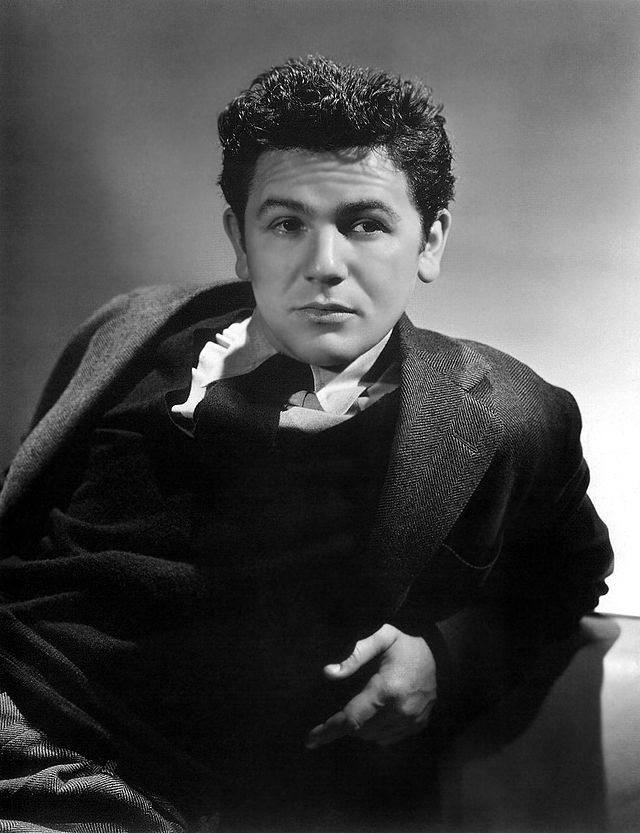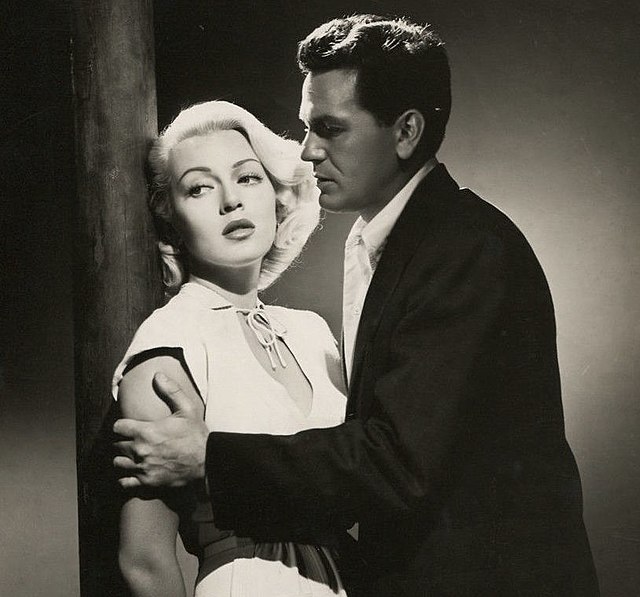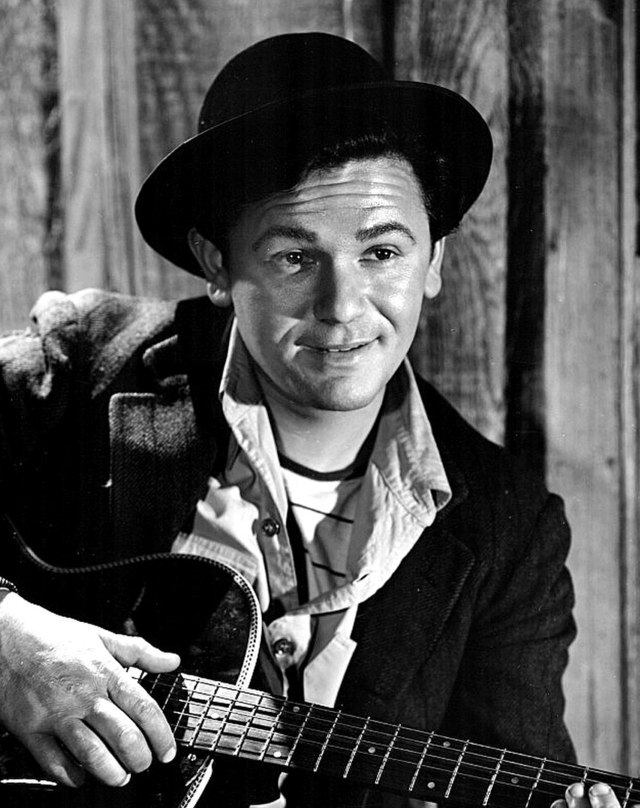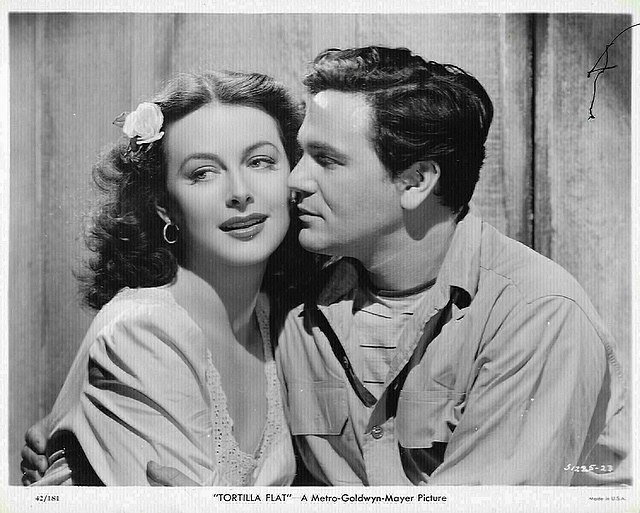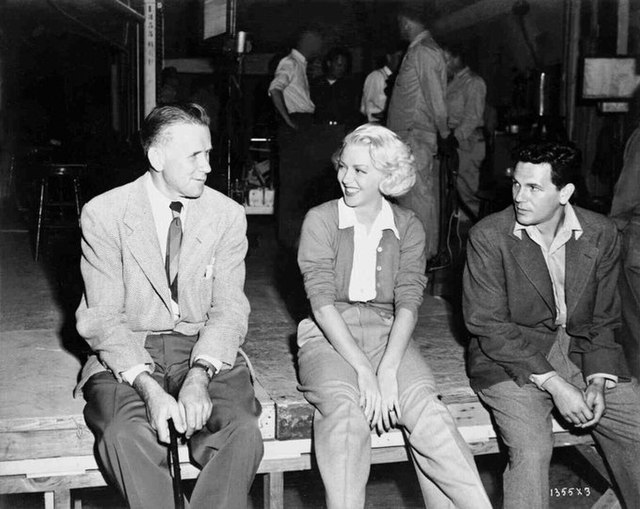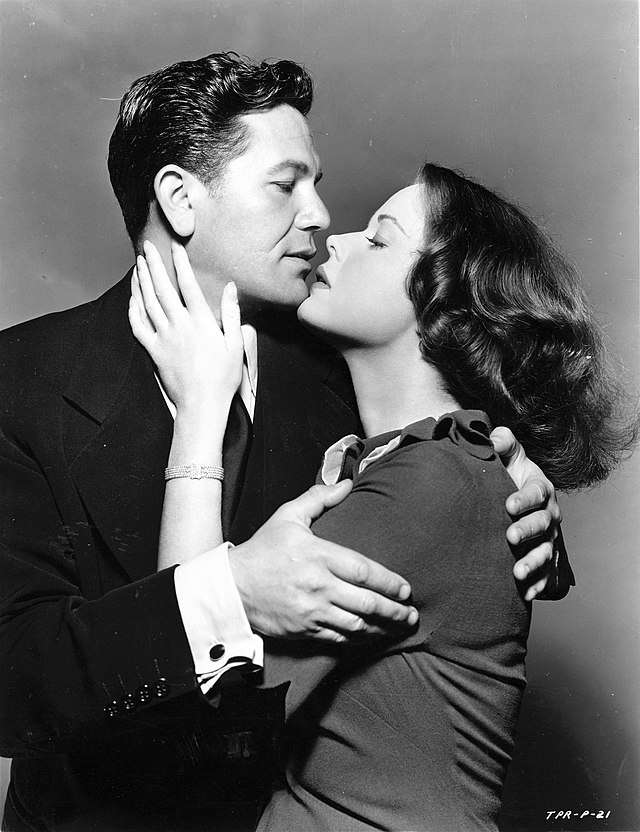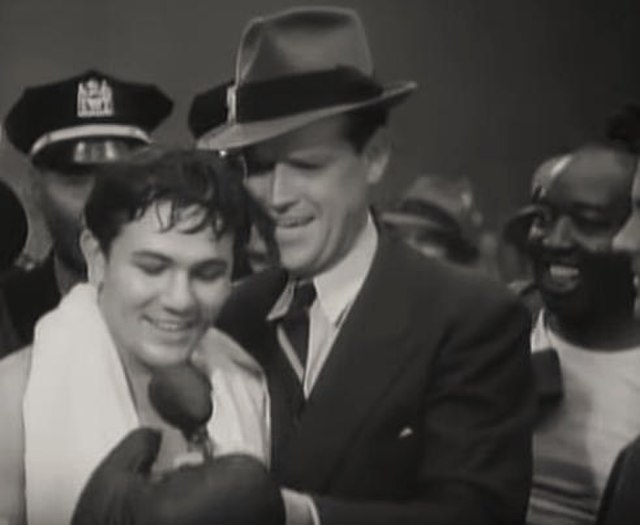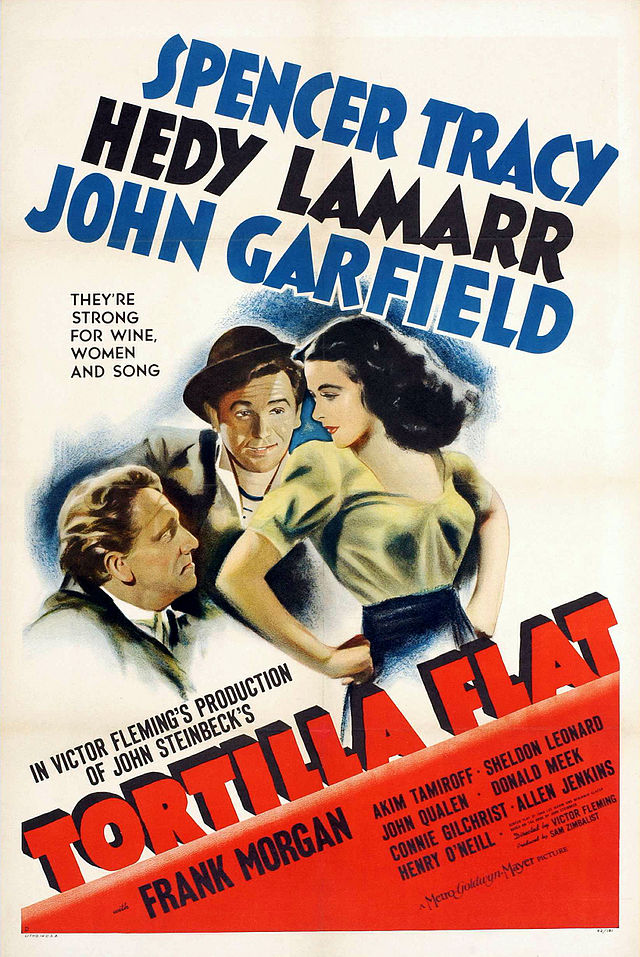John Garfield (1913- 1952)
Biography and Movie Career
John Garfield, born Jacob Julius Garfinkle on March 4, 1913, in New York City, emerged as one of Hollywood's most authentic and naturalistic actors, renowned for his intense performances and his gritty, working-class appeal. Garfield's career was defined by his blend of charisma and toughness, which gave depth to his roles and often brought a raw, vulnerable edge to Hollywood’s golden age.
Early Life and Personal Struggles
Garfield was born into a poor Jewish family on New York’s Lower East Side. His father, David Garfinkle, was a cloth cutter who struggled to provide for the family, especially after Garfield’s mother, Hannah, died when he was just seven. Her death affected him deeply, contributing to a rebellious streak that marked his youth. Moving between relatives and foster homes, Garfield faced various hardships, including a bout of rheumatic fever that permanently affected his health.
In school, he was known as a troublemaker and often got into fights, though teachers noticed his natural intelligence and flair for performance. A teacher named Angelo Patri recognized his potential and introduced him to drama, believing acting might help him channel his energy. Garfield attended the Heckscher Foundation's drama school and later joined the left-leaning Civic Repertory Theatre, where he studied under the legendary Lee Strasberg and honed his craft in the burgeoning "Method" style of acting.
Path Towards Success and Breakthrough Roles
In 1932, Garfield joined the Group Theatre, a New York collective that prioritized realism and social issues in theater, where he became close friends with actors like Clifford Odets. His stage success, especially in Odets’ play Golden Boy, brought him to Hollywood's attention, and Warner Bros. signed him in 1937.
Garfield’s film debut was Four Daughters (1938), in which his performance as a troubled musician brought him immediate fame and his first Oscar nomination for Best Supporting Actor. His tough-guy persona, along with a genuine sensitivity and emotional depth, made him stand out among Hollywood’s leading men. Audiences responded to his authentic representation of working-class characters, a style he maintained in subsequent roles in films like They Made Me a Criminal (1939) and The Sea Wolf (1941).
During World War II, Garfield passionately supported the war effort, joining the Hollywood Canteen and entertaining the troops. Although he was ineligible for military service due to his health, he made contributions through war-themed films like Air Force (1943) and by organizing bond drives. His experiences with the war effort and his respect for service members deepened his resolve to address real issues through his acting.
Family Life and Passions
Garfield married Roberta Seidman, a teenage sweetheart, in 1935, and they remained together until his death. They had three children, Katherine, David, and Julie. Though Garfield deeply loved his family, his marriage was complicated by his struggle with fame and long-standing health issues, as well as Hollywood’s intense demands. His career passions often took precedence, and he sought solace in his work, at times creating distance between himself and his family.
Garfield was a man of principle and was deeply passionate about social justice. He advocated for racial equality and worker's rights, leading to his active involvement with left-wing causes, which would later impact his career. His friendship with many politically active artists and his affiliation with the Hollywood Independent Citizens Committee of the Arts, Sciences, and Professions made him a target in Hollywood during the McCarthy era.
The Hollywood Blacklist and Career Decline
After World War II, Garfield’s career entered a new phase with classic films like The Postman Always Rings Twice (1946), where he starred opposite Lana Turner. His role in Body and Soul (1947), for which he received an Oscar nomination, was one of his proudest achievements, as it explored the exploitation of boxers, a topic close to his heart given his own struggles in Hollywood.
However, the late 1940s saw the rise of the Hollywood blacklist, where actors, directors, and writers suspected of Communist affiliations were denied work. Though Garfield had never joined the Communist Party, his political affiliations and friendships led to suspicions. He was subpoenaed to testify before the House Un-American Activities Committee (HUAC) in 1951, where he refused to name others involved in progressive movements. This choice effectively ended his career; Warner Bros. dropped him, and he faced difficulties finding work in Hollywood.
Health Issues, Final Years, and Death
With his career and reputation shattered, Garfield’s health declined sharply. The emotional strain, combined with his ongoing heart condition, took a significant toll. Garfield spent his last years largely isolated, struggling financially and emotionally. He managed to make one final film, He Ran All the Way (1951), which featured him as a desperate man on the run. His performance was powerful, but by then, his spirit was deeply wounded.
On May 21, 1952, John Garfield died of a heart attack at age 39. He was found in the New York City apartment of a female friend, where he had reportedly spent his final night. His premature death was largely attributed to the combined stress of his physical condition and the emotional impact of the Hollywood blacklist, which had devastated his career and personal life.
Legacy
John Garfield is remembered as a pioneer of realistic acting, preceding the rise of other Method actors like Marlon Brando and James Dean. His work continues to influence generations of actors for its gritty authenticity and emotional resonance. Despite a career cut short, Garfield’s legacy as a true artist who challenged Hollywood’s norms endures, and his films remain a testament to his immense talent and dedication to his craft.
Short Video Bio on John Garfield
Naturalistic Acting Style of John Garfield
John Garfield’s acting style was revolutionary for its time, characterized by a raw intensity and authenticity that broke away from the polished, often theatrical performances typical of Hollywood in the 1930s and 1940s. Garfield’s performances felt personal, earthy, and spontaneous, drawing audiences into the emotional core of his characters, who often struggled with inner conflicts, moral dilemmas, and the harsh realities of life.
Naturalism and Realism
Garfield was one of the first actors in Hollywood to bring a truly naturalistic style to the screen. He was deeply influenced by his early training at the Group Theatre in New York, where he studied Method acting under the guidance of Lee Strasberg and Stella Adler. Method acting emphasized emotional truth and realism, techniques Garfield used to develop the complex emotional landscapes of his characters. Unlike many actors of his time, Garfield approached his roles from a psychological perspective, seeking to understand the motivations, fears, and desires of each character. He would often immerse himself fully in his characters’ backstories, making his performances feel like genuine human experiences rather than staged portrayals.
Unrefined Toughness with Vulnerability
Garfield was known for bringing a rough-edged masculinity to his roles, portraying working-class men with an intensity that made him stand out in a Hollywood dominated by polished leading men. His characters often displayed a blend of ruggedness and sensitivity, a combination that became his trademark. This duality allowed him to portray men who were tough on the surface but deeply affected by their vulnerabilities and moral conflicts. In films like Body and Soul and The Postman Always Rings Twice, Garfield played men grappling with the darkness around and within them, making his portrayals deeply relatable and tragic.
A Voice and Physicality That Embodied Everyman Struggles
Garfield’s voice and physical presence were integral to his style. His voice had a gritty, nasal quality that conveyed frustration, desire, and the tension of a man perpetually struggling against his circumstances. His diction was natural and colloquial, another departure from the more formal, articulate styles of his peers. Physically, he brought a restless energy to his performances, moving with an unpolished ease that added authenticity to his portrayals. Even the way he would slump his shoulders or shift his stance communicated his characters’ sense of being weighed down by life’s pressures.
Emotional Range and Intensity
Garfield had a rare ability to convey a wide range of emotions without relying on dramatic gestures. His performances were marked by small, almost imperceptible shifts in expression that allowed him to display complex feelings, such as regret, fear, love, and inner turmoil, with subtlety. In a film like Force of Evil, where he plays a lawyer grappling with his involvement in the corrupt underworld, Garfield uses his face, posture, and voice to gradually reveal his character’s moral descent and self-loathing. His eyes, in particular, were a powerful tool; they could communicate anger, longing, or desolation with just a glance, making his characters feel incredibly alive.
Anti-Hollywood Persona
Garfield’s style resonated deeply with the working-class audiences who saw him as “one of their own.” Unlike the suave, polished image typical of Hollywood stars, Garfield brought a sense of realism and relatability to his roles. His characters were flawed, conflicted, and driven by survival rather than idealism. This anti-hero persona, combined with his method acting approach, made him one of the first true “everyman” actors in Hollywood. He pioneered a style that didn’t rely on glamour but instead on depth and integrity, paving the way for later generations of actors like Marlon Brando, James Dean, and Robert De Niro.
Social and Political Influence on His Craft
Garfield’s acting style was also influenced by his social consciousness and commitment to representing real, often marginalized people. His deep empathy for the underdog, combined with his personal convictions, informed his choice of roles. Films like Gentleman’s Agreement and We Were Strangers reflect Garfield’s commitment to using his craft as a vehicle for addressing issues like anti-Semitism, prejudice, and social justice. His performances in such films are marked by a sense of urgency, as if he saw himself not just as an actor, but as a voice for those facing oppression.
Legacy
John Garfield’s acting style became a blueprint for future Method actors, who would continue to push for realism and emotional depth in Hollywood. His ability to reveal the flawed humanity of his characters made him a trailblazer, challenging the norms of the studio system. Garfield’s intense, emotionally charged performances continue to influence actors today, reminding audiences of the power of authenticity and vulnerability in film. His legacy lies in his fearless embrace of the imperfect, and his career remains a testament to the impact of honest, raw performance in American cinema.
Personal Quotes
• On Acting and Authenticity:
"I’ve always wanted to play the really tragic kind of guy, the ones who try to fight against the odds and get licked."
• On Realism in Performance:
"The best part about acting is not the fame or the money; it’s the opportunity to tell the truth. People will always respond to honesty."
• On Hollywood and Integrity:
"With me, it’s always been the truth or nothing. I can’t play a character unless I believe in him. I guess I’m what they call a ‘difficult’ actor."
• On His Approach to Roles:
"When you come up the hard way, you have to develop character. You have to work twice as hard, but it’s worth it because you can bring something real to the people watching."
• On Social Justice and Art:
"I want to play people that live. People who are real. The street people, who are the pulse of our country, the essence of its strength."
• On His Troubled Youth and Finding Purpose:
"I was in trouble a lot as a kid. But it taught me a lot, and one day, I found acting. It gave me purpose. It gave me a way out."
• On Conformity and Pressure in Hollywood:
"They want everybody to fit into a mold, to act like the All-American boy. But I’m from the streets, and the only thing I know how to do is be myself."
• On the Hollywood Blacklist and Standing Up for Principles:
"I refuse to be a traitor to myself and my friends, and I refuse to live in fear. I’ll stand for what I believe is right, even if it costs me."
• On the Complexity of Human Nature:
"We’re all prisoners in our own way. I like to play the guys who aren’t perfect, who have weaknesses and secrets like the rest of us."
• Reflecting on His Career:
"I was just a guy from the streets who wanted to make good. I never dreamed it would take me this far. But all I wanted was to give something real, something honest."
What Others said about John Garfield
• Elia Kazan (Director)
"John Garfield didn’t act his characters—he lived them. I don’t think there’s been anyone else like him on the screen. He didn’t fit into Hollywood’s polished mold, and that’s what made him so electric."
• Clifford Odets (Playwright and Friend)
"Johnny was one of the real people. He never forgot where he came from, and he wasn’t about to compromise who he was for anyone. He was his own man, an artist with principles and passion."
• James Dean (Actor, often cited as influenced by Garfield)
"Watching him, you didn’t see a star; you saw a real person, someone with pain, anger, love. He was raw and honest. That’s what made him great. That’s what makes people like him unforgettable."
• Marlon Brando (Actor)
"Garfield had something the rest of us wanted—an unforced intensity. You felt his life behind the characters he played. He brought a kind of nakedness to the screen."
• Lee Strasberg (Acting Teacher, Method Acting Pioneer)
"Garfield was a trailblazer for actors who followed him. He brought the Method to Hollywood before it even had a name. He was true to himself, his roots, and his values, and that showed in every performance he gave."
• Pauline Kael (Film Critic)
"John Garfield was the first modern actor. He didn’t care about being charming or conventionally good-looking; he cared about being real. His characters were flawed, vulnerable, and entirely human. He made the anti-hero a leading man."
• Lana Turner (Co-star in The Postman Always Rings Twice)
"John was intense and passionate, always giving everything he had. He believed in his roles with every part of him. He pushed me as an actress to be better, to be braver."
• Martin Scorsese (Director)
"Garfield was one of the true originals. He had that intensity, that unpredictability that makes an audience feel like they’re watching something true. He wasn’t playing a role; he was creating a life. His style was revolutionary and remains unmatched."
• Julie Garfield (Daughter)
"My father was a fighter, and he brought that fighter’s heart to everything he did. He wasn’t afraid to stand up for what he believed in, even if it meant sacrificing his career. He was a proud man, a man of conviction, and that’s how he should be remembered."
• Humphrey Bogart (Actor and Contemporary)
"Johnny was always a guy you could count on. He wasn’t interested in the Hollywood glamour. He was interested in telling the truth. He had a different way of approaching acting that made the rest of us pay attention."
• Kirk Douglas (Actor)
"Garfield was ahead of his time. He was one of the first actors who didn’t need the big gestures or the grand speeches. He showed us that the quiet moments, the small gestures, could speak volumes."
• The Hollywood Reporter (Obituary, 1952)
"John Garfield’s death at the young age of 39 leaves an irreplaceable void. He brought to American cinema a realism and humanity that will endure as part of his legacy, inspiring actors who strive to bring truth to their work."
Awards and Recognition
Academy Award Nominations
Garfield received two Oscar nominations, both in the Best Actor and Best Supporting Actor categories. His performances, marked by intensity and authenticity, made him a standout actor in an era where few roles were written with such depth.
• 1939 – Best Supporting Actor Nomination for Four Daughters
Garfield’s breakthrough role as Mickey Borden, a brooding and sensitive musician, earned him his first Oscar nomination. His performance, a rare blend of emotional vulnerability and ruggedness, was widely praised, helping to elevate his reputation as an actor and introducing his distinctive style to Hollywood.
• 1947 – Best Actor Nomination for Body and Soul
Garfield earned his second Oscar nomination for his powerful performance as Charlie Davis, a conflicted boxer grappling with the corrupt nature of professional boxing. This role is considered one of his most significant, as it not only showcased his acting depth but also underscored his commitment to telling stories that addressed social issues. Body and Soul remains one of the great boxing films and is widely regarded as a career-defining role for Garfield.
Other Recognition During His Career
Although Garfield was not awarded many formal accolades during his career, he was widely celebrated by critics and audiences. His unique acting style and ability to portray deeply human characters brought him significant acclaim:
• New York Film Critics Circle Awards
While Garfield did not win any NYFCC awards, his performances were frequently acknowledged by critics. His work in The Postman Always Rings Twice (1946) and Force of Evil (1948) received critical praise, though these performances did not earn specific awards. Nonetheless, Garfield was celebrated in New York City, his hometown, for his contributions to more realistic, character-driven performances.
Posthumous Recognition
After his death, Garfield’s legacy only grew, with renewed appreciation for his pioneering style, which laid the groundwork for Method acting in Hollywood.
• Hollywood Walk of Fame
Garfield was posthumously awarded a star on the Hollywood Walk of Fame at 7065 Hollywood Boulevard. The recognition highlights his lasting impact on Hollywood and his contributions to film history as one of the first actors to bring a more naturalistic approach to the screen.
• Academy’s Acknowledgment of Early Method Acting
In various retrospectives and exhibitions, the Academy of Motion Picture Arts and Sciences has highlighted Garfield’s work as an early proponent of Method acting in Hollywood. His influence on actors such as Marlon Brando, Montgomery Clift, and James Dean is often cited, placing him in the pantheon of transformative actors.
Other Tributes and Retrospectives
• Film Society of Lincoln Center
The Film Society of Lincoln Center in New York has held retrospectives on Garfield’s career, examining his influence on American cinema and showcasing his most memorable films. These events celebrated his dedication to socially conscious storytelling and his role as a trailblazer for the “everyman” actor archetype.
• TCM (Turner Classic Movies) Tributes
Garfield has been a frequent subject of TCM tributes, especially during film festivals and special programming blocks dedicated to classic Hollywood. These tributes have highlighted films like The Postman Always Rings Twice and Body and Soul, recognizing Garfield as a groundbreaking performer who helped shape modern acting.
• Legacy in Acting Circles
While not formal awards, Garfield’s legacy has had an enduring influence on actors who value authenticity, social consciousness, and realism in their craft. His style became a model for many actors in the following generations, and his contributions to acting are widely studied in acting schools and discussed by film historians.
Movies Starring John Garfield
1938
• Four Daughters
Garfield’s breakthrough role as Mickey Borden, a brooding musician who falls in love with one of four musically talented sisters. This romantic drama explores family, love, and tragedy.
1939
• They Made Me a Criminal
Garfield plays a boxer framed for murder who goes on the run, hiding out on a farm with a group of troubled youths. This crime drama reflects his knack for portraying misunderstood, conflicted characters.
• Daughters Courageous
A quasi-sequel to Four Daughters but with different characters. Garfield plays Gabriel Lopez, a drifter who disrupts a family reunion, bringing romantic entanglements and family tension.
• Dust Be My Destiny
Garfield portrays Joe Bell, a man wrongly convicted and sent to prison who falls in love with a fellow prisoner’s stepdaughter. They struggle to make a life despite society’s mistrust of them.
• Blackwell's Island
In this crime thriller, Garfield is a crusading reporter sent undercover to Blackwell’s Island prison to expose corruption.
1940
• Castle on the Hudson
Garfield stars as a convicted thief trying to escape prison, only to find redemption in a relationship with his girlfriend who stands by him.
• Saturday’s Children
Garfield plays Rims Rosson, a young man who marries a coworker, and they struggle with financial difficulties and their new roles in society.
1941
• Flowing Gold
This drama centers around Garfield as a rugged oil driller on the run from the law who becomes involved in the dangerous life of wildcat oil prospecting.
• East of the River
Garfield stars as an ex-con who tries to help his friend’s son avoid a life of crime, reflecting his recurring theme of redemption.
• The Sea Wolf
Garfield plays a young fugitive who boards a ruthless sea captain's ship, only to face harsh conditions at sea and a life-altering adventure.
1942
• Tortilla Flat
Based on John Steinbeck’s novel, Garfield stars alongside Spencer Tracy and Hedy Lamarr in this comedy-drama about two drifters and their love-hate relationship in a small town.
• Dangerously They Live
In this WWII spy thriller, Garfield portrays a doctor who becomes entangled in a plot involving a Nazi spy ring after helping an amnesiac patient.
1943
• Air Force
Garfield is a gunner on a U.S. Army bomber plane sent to the Pacific after the Pearl Harbor attack. This patriotic war film follows the crew’s experiences in combat.
1944
• Between Two Worlds
Garfield stars in this supernatural drama about passengers on a ship who slowly realize they’re all dead and must face judgment for their lives.
1946
• The Fallen Sparrow
Garfield plays John McKittrick, a WWII vet seeking to solve his friend’s mysterious death, getting embroiled in espionage and betrayal.
• The Postman Always Rings Twice
Garfield stars as a drifter who begins a torrid affair with a diner owner’s wife, leading them down a dark path of murder and deception. This film noir is one of Garfield’s most iconic roles.
1947
• Nobody Lives Forever
Garfield plays a con artist planning to swindle a wealthy widow, only to fall in love with her, leading him to reconsider his criminal life.
• Body and Soul
A seminal boxing drama where Garfield plays Charlie Davis, a boxer who becomes trapped in the corrupt world of fight promotion, torn between his career and moral choices.
1948
• Gentleman’s Agreement
Although Garfield has a supporting role, this important film tackles anti-Semitism. He plays a Jewish war veteran who encourages a journalist to write about bigotry in America.
• Force of Evil
Garfield stars as Joe Morse, a lawyer aiding his brother’s numbers racket. This noir film dives into the moral consequences of greed and corruption.
1949
• We Were Strangers
Set in Cuba, Garfield plays an American revolutionary who joins locals in a plot to overthrow the government. This John Huston-directed film was controversial for its political themes.
1950
• Under My Skin
Garfield portrays an American jockey on the run in Italy after double-crossing a mob boss. The film explores loyalty and redemption in the underworld.
1951
• He Ran All the Way
In Garfield’s final film, he plays Nick Robey, a small-time criminal who botches a robbery and hides in a family’s apartment, taking them hostage. This film noir illustrates Garfield’s powerful ability to portray a desperate man on the edge.

